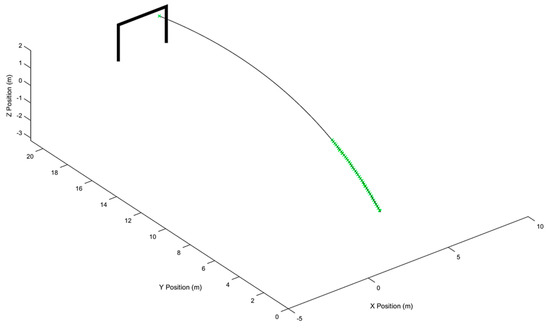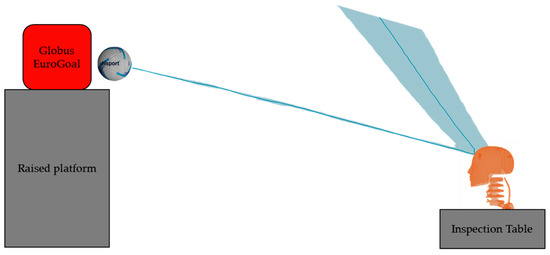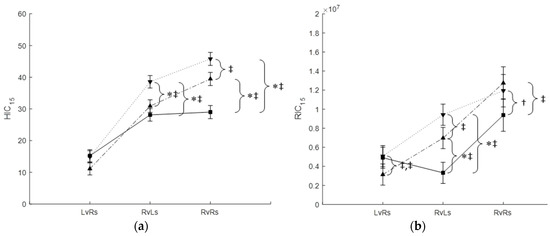Abstract
In youth association football, the use of different size and/or mass footballs might represent a feasible intervention for addressing heading impact severity and player safety concerns. This study assessed the effects of football size and mass on head impacts based on defensive heading in youth football. Three-dimensional trajectories of U16 youth academy free kicks were modelled to derive three impact trajectories, representing defensive heading in youth football. Three football models (standard: S5, standard-light: S5L, and small: S4) impacted an instrumented headform; Head Injury Criterion (HIC15) and Rotational Injury Criterion (RIC15) were calculated. For headform impacts, S4 and S5L footballs yielded lower HIC15 magnitudes than S5 footballs. Further, S4 footballs yielded lower HIC15 and lower RIC15 magnitudes than S5 and S5L footballs. Initial findings indicated that smaller, S4 footballs reduced linear and rotational head injury criteria for impacts representative of defensive heading in youth football.
1. Introduction
Association football is a globally popular sport; an estimated 248 million adult and 22 million youth players participate worldwide [1]. Recently, links between repetitive heading, a core skill in football, and chronic traumatic encephalopathy (CTE), a potential neurodegenerative cause of dementia and motor impairments, have been made [2]. However, such observational links do not provide insight into injury risk or causality. Whilst concussive injuries can inflict acute symptoms ranging from blurred vision to unconsciousness, sub-concussive injuries often go unnoticed by players [3]. Sub-concussive injuries might have accumulative and long-term effects, ranging from impaired neurocognitive performance [3,4] to CTE [5]. This is a concern in youth football, owing to unclear evidence surrounding repetitive football heading and brain development [6].
Heading practice in youth football varies. In 2015, the US Soccer Federation implemented a ban on heading for U10 age groups and limit to U14 age groups [7]. However, this remains a controversial strategy. For example, Comstock et al. [8] postulated that banning heading practice in youth football would have a limited effect on the prevention of concussion injury. The authors highlighted that player-on-player contacts, which account for more than twice the concussion injury rate than heading in their research, must be concurrently addressed with heading practice recommendations to be effective [8]. In England, FA competition standards in youth football identify the use of different size footballs for different age groups (e.g., U7–U9: size three football; U10–U14: size four football; all other age groups: size five football) [9]. FIFA youth football recommendations present a blend of football size and mass for different age groups [10]. Recommendations are not enforced, but rather are guidelines to be interpreted by local member associations. Regardless, evidence surrounding youth football heading and the effects of different footballs—which present different mass, radius, and panel properties—to support changing football practice, is not clear.
The effects of football mass and pressure on head impact response have been investigated. Shewchenko et al. [11] reported that lower mass footballs reduce peak linear accelerations experienced in heading, owing to less energy being transferred to the head. However, changes to rotational accelerations with reduced ball mass were reported to be inconsistent, owing to variation in ball speed, participant heading technique, and measurement sensitivity [11]. Further, mild increases to rotational acceleration were reported for lower pressure (i.e., less stiff) balls, which possibly reflected different energy transfer mechanisms; however, findings were inconsistent [11].
Limited research has addressed the effects of football size on head impacts. In a mathematical model, Babbs [12] estimated linear accelerations of adult and youth heading for size five and size four footballs, respectively. When ball size and player-football effective masses were accounted for, linear head accelerations were estimated to be marginally higher for youth heading with size four footballs. However, empirical evidence addressing the effects of different size and mass footballs for heading impacts that are representative of youth football is limited. The purpose of this study was to assess the effects of football size and mass in heading impacts that are representative of defensive heading in youth football.
2. Materials and Methods
All procedures were approved by the Research Ethics Committee of the Faculty of Health and Wellbeing, Sheffield Hallam University.
2.1. Youth Football Defensive Heading Trajectory
To provide football heading impact trajectories that are representative of defensive heading in youth football, existing three-dimensional football trajectory data [13] were modelled. Twenty targeted free kicks (~20 m from the goal), performed by four U16 youth academy players (e.g., Figure 1), were modelled to estimate inbound football velocity and spin at the point-of-goal, to represent a defensive clearing header from the goal line. Mean inbound football velocity and spin at the point-of-goal defined a representative trajectory (Rv-RsTraj) that existed within repeatable, mechanical projection limits. Two further trajectories were modelled to yield a representative-velocity and low-spin trajectory (Rv-LsTraj), and a low-velocity and representative-spin trajectory (Lv-RsTraj). Trajectories were modelled on variation within representative trajectory data, as well as repeatable mechanical projection limits (velocity, spin: Rv-RsTraj = 18.5 m∙s−1, 42.8 rad∙s−1; Rv-LsTraj = 18.5 m∙s−1, 16.0 rad∙s−1; Lv-RsTraj = 14.7 m∙s−1, 42.8 rad∙s−1).

Figure 1.
Three-dimensional trajectory of U16 academy player free kick (adapted from Choppin [13]).
2.2. Experimental Setup
Three football models (Uhlsport GmbH, Germany) were selected: a standard size five (S5: Nitro Synergy) football, a size five light (S5L: 350 Synergy Lite) football, and a size four (S4: Nitro Synergy) football (mass, circumference: S5 = 0.41 kg, 0.69 m; S5L = 0.35 kg, 0.68 m; S4 = 0.37 kg, 0.65 m). All footballs were inflated to their recommended pressure (12.0 PSI). To replicate the downward, inbound trajectory of defensive headers, footballs were projected using a EuroGoal (1500, Globus, Italy) mounted on a raised platform to impact a Hybrid III 50th Percentile Male (Humanetics, Germany) headform (Figure 2). The headform was mounted atop a flexible neck, fixed to an industrial inspection table, and instrumented with a Slice Nano (6DX PRO 2K-18K, DTS, USA), which contained a triaxial accelerometer (±2000 g) and triaxial angular rate sensor (±18,000°/s), both sampling at 50,000 Hz. The EuroGoal was positioned at 1.28 m and 1.15 m relative to the headform in the sagittal plane to yield corresponding impact angles of 16.5° and 18.3° for Rv and Lv football trajectories, respectively. The headform generated a square-wave trigger upon detection of headform acceleration > 5 g. This event was used to capture accelerometer and gyroscope data 0.150 s pre- and 0.166 s post-trigger, and to trigger two gen-locked high-speed cameras (Miro, Vision Research, USA), operating at 2000 Hz (resolution: 1280 × 800 p) with a 0.150 s pre-trigger. The master camera was perpendicular to inbound trajectories to allow verification of football velocity and spin during testing using SpinTrack3D (Centre for Sports Engineering Research, Sheffield Hallam University, UK). The slave camera was set up at an intersection angle of ~60°; both cameras were calibrated using Check3D (Centre for Sports Engineering Research, Sheffield Hallam University, UK) to allow three-dimensional position reconstruction of football trajectories. To minimise football degradation, twenty footballs of each model were sourced to ensure they were not projected on more than three occasions.

Figure 2.
Experimental setup of EuroGoal, headform, and example impact trajectories.
2.3. Data Analysis
Three-dimensional linear and rotational acceleration data were low-pass filtered using an eighth order, zero-lag Butterworth filter with a 200 Hz cut-off frequency, and resultant direction accelerations calculated. Subsequently, linear and rotational impact severity indexes Head Injury Criterion (HIC15) and Rotational Injury Criterion (RIC15) were calculated with the following [14]:
where and represent linear and rotational acceleration as a function of time, respectively; represents the sample time interval; and identifies the timespan (15 ms) during which HIC and RIC values are integrated.
For football-headform impacts, root-mean-square error, given as , was calculated for all measured inbound velocities and spin rates. Following the removal of outliers, effects of impact trajectory and football model on peak linear acceleration, peak rotational acceleration, HIC15, and RIC15 were assessed for 81 (n = 9 trials × 3 footballs × 3 trajectories) impacts, using a two-way ANOVA (natural log transformed; alpha set to 0.05) with Tukey HSD pairwise comparisons using MATLAB (2018a, MathWorks, USA). Effect sizes were also calculated as and interpreted as representing small (0.2), moderate (0.5), and large (>0.8) effects.
3. Results
3.1. Football-Headform Impacts
Table 1 presents velocity (Rv and Lv) and spin rate (Rs and Ls) components for S5, S5L, and S4 football impacts. For all footballs and all trajectories, RMSE for inbound velocities and spin rates was ≤2.3 m∙s−1 and ≤9.3 rad∙s−1, respectively. Across all impact trajectories, peak linear accelerations were between 52 and 246 g, and peak rotational accelerations were between 3095 and 9601 rad∙s−2. Coefficient of variation (repeat impacts) was 2.9–19.8% and 3.6–16.9% for peak linear acceleration and peak rotational acceleration, respectively. Inbound trajectories RvRsTraj, RvLsTraj, and LvRsTraj derived main effects for peak linear acceleration (P < 0.001), peak rotational acceleration (P < 0.001), HIC15 (P < 0.001), and RIC15 (P < 0.001).

Table 1.
Mean and standard deviation for football velocity (Rv and Lv) and spin (Rs and Lv) of inbound trajectories, and outbound trajectory angle (transverse plane), for S5, S5L, and S4 footballs.
3.2. Head Impact Severity
For HIC15 and RIC15 head impact severity indexes, trajectory and football interaction effects were evident (Figure 3). For RvRsTraj impacts, comparisons identified greater HIC15 magnitudes for S5 footballs versus S4 footballs (P < 0.001, |ESB| = 2.98), and for S5L footballs versus S4 footballs (P < 0.001; |ESB| = 2.53). Further, trends toward greater HIC15 magnitudes were identified for S5 footballs versus S5L footballs (P = 0.296; |ESB| = 0.95). For RvLsTraj impacts, comparisons identified greater HIC15 magnitudes for S5 footballs versus S5L footballs (P = 0.009; |ESB| = 1.96), and for S5 footballs versus S4 footballs (P < 0.001; |ESB| = 3.74).

Figure 3.
HIC15 (a) and RIC15 (b) for S4 (∎), S5L (▲), and S5 (▼) footballs for LvRsTraj, RvLsTraj, and RvRsTraj trajectory impacts. RIC15 magnitudes are × 107. * Significant difference between footballs (P < 0.05). † and ‡ indicate moderate and large between football effect sizes, respectively.
For RvRsTraj impacts, comparisons identified trends toward greater RIC15 magnitudes for S5 footballs versus S4 footballs (P = 0.965; |ESB| = 0.59), and for S5L footballs versus S4 footballs (P = 0.507; |ESB| = 1.12). For RvLsTraj impacts, comparisons identified greater RIC15 magnitudes for S5 footballs versus S4 footballs (P < 0.001; |ESB| = 3.51), and for S5L footballs versus S4 footballs (P < 0.001; |ESB| = 2.92). Further, trends toward greater RIC15 magnitudes were identified for S5 footballs versus S5L footballs (P = 0.450; |ESB| = 1.34). Finally, for LvRsTraj impacts, trends toward greater RIC15 magnitudes for S5 footballs versus S5L footballs (P = 0.086; |ESB| = 1.24), and for S4 footballs versus S5L footballs (P = 0.068; |ESB| = 2.12), were observed.
4. Discussion
The purpose of this study was to assess the effects of football size and mass in head impacts representative of defensive, clearing headers in youth football. Based on U16 free kicks (~20 m from the goal) [13], an instrumented headform was impacted with S5, S5L, and S4 footballs using three modelled trajectories. RvRsTraj, RvLsTraj, and LvRsTraj trajectories were used to characterise representative-velocity and representative-spin, representative-velocity and low-spin, and low-velocity and representative-spin impacts, respectively. Main effects observed for peak linear acceleration, peak rotational acceleration, HIC15, and RIC15 indicated that RvRsTraj, RvLsTraj, and LvRsTraj trajectories derived different heading impacts. However, observed trajectory and football interaction effects indicated that impact responses were football dependent.
When considering linear head impact severity, HIC15 magnitudes between footballs did not correspond to football mass alone. For example, lower HIC15 magnitudes were observed for S5L versus S5 footballs during RvLsTraj impacts, and indeed, corresponding trends were observed during RvRsTraj impacts (Figure 3). However, S4 football (mass = 0.37 kg) impacts yielded HIC15 magnitudes lower than both S5 and S5L (mass = 0.41 kg and 0.35 kg, respectively) football impacts, during both RvLsTraj and RvRsTraj impacts. Reduced S4 football HIC15 magnitudes, which corresponded to large effects for both RvLsTraj and RvRsTraj impacts (Figure 3), were therefore dependent on factors other than mass alone. When considering rotational head impact severity, lower RIC15 magnitudes were observed for S4 footballs versus S5 and S5L footballs during RvLsTraj impacts (Figure 3). Further, corresponding trends of lower S4 RIC15 magnitudes were observed during RvRsTraj impacts (Figure 3), corresponding to moderate and large effect sizes between S5 and S5L footballs, respectively. Current findings cannot delineate whether football size alone derived observed RIC15 effects; however, Shewchenko et al. [11] previously indicated football stiffness as a potential mechanism.
The football-head interaction represents an important mechanism for the understanding of energy transfer in football heading. For example, when impacting Jabulani and Cafusa footballs with a “kick-robot,” Koizumi et al. [15] reported greater peak impact force and impulse for the Jabulani. It was indicated that different materials and panel design characteristics, including bonding and stitching, contributed to greater football stiffness. Whilst football stiffness was not assessed in the current study, material composition was similar (e.g., polyurethane and foam layer) and inflation pressures consistent between footballs. However, S4 footballs comprised 32 × 40 mm sided hexagon and pentagon panels, a direct scaling of the 32-panel design used in S5 and S5L footballs (e.g., 32 × 45 mm sided hexagon and pentagon panels). Observed velocity and spin rate effects on HIC15 and RIC15 for S5, S5L, and S4 footballs (Figure 3) might, therefore, indicate different interaction mechanisms between footballs (e.g., stiffness, contact area, deformation, etc.). Whilst not addressed by the current study, larger transverse plane outbound angles for S4 footballs (Table 1) might reflect different interaction mechanisms. However, the current study did not address football-headform interaction, and therefore cannot identify specific football-head interaction mechanisms.
In youth football, sub-concussive heading injuries are associated with immediate cognitive impairment, and, although transient, may have accumulative effects on long-term brain health [4]. Any mechanism that might reduce the severity of heading impacts in football practice, should, therefore, be investigated. Initial findings indicated that, for head impacts representative of defensive heading, S4 footballs yielded lower HIC15 and RIC15 magnitudes than S5 and S5L footballs, corresponding to moderate and large effects. Whilst included to explore football-headform impact response, the use of impact trajectories based on U16 free-kick performance might limit the application of current findings. Further, the use of an adult headform, mounted atop a flexible neck fixed to an inspection table, might not fully represent head-football interactions observed in youth heading performance. However, and for comparable impacts, initial findings indicate lower HIC15 and RIC15 magnitudes for S4 footballs during head impacts representative of defensive heading. Further research to investigate specific football-head interaction mechanisms is therefore warranted.
5. Conclusions
This study assessed the effects of football size and mass in head impacts representative of defensive headers in youth football. Initial findings indicated that smaller, size four footballs reduced linear and rotational head injury criteria for impacts representative of defensive heading in youth football. Further research to investigate specific football-head interaction mechanisms is warranted.
Acknowledgments
The authors would like to thank Johsan Billingham (Research Manager, FIFA) for project guidance, support, and sourcing of footballs for impact tests.
Conflicts of Interest
The authors declare no conflict of interest.
References
- FIFA Big Count 2006: 270 Million People Active in Football. Available online: https://fifa.com/mm/document/fifafacts/bcoffsurv/bigcount.statspackage_7024.pdf (accessed on 12 November 2019).
- Ling, H.; Morris, H.; Neal, J.; Lees, A.; Hardy, J.; Holton, J.; Revesz, T.; Williams, D. Mixed pathologies including chronic traumatic encephalopathy account for dementia in retired association football (soccer) players. Acta Neuropathol. 2017, 133, 337–352. [Google Scholar] [CrossRef] [PubMed]
- Bailes, J.; Petraglia, A.; Omalu, B.; Nauman, E.; Talavage, T. Role of subconcussion in repetitive mild traumatic brain injury. J. Neurosurg. 2013, 119, 1235–1245. [Google Scholar] [CrossRef] [PubMed]
- Di Virgilio, T.; Hunter, A.; Wilson, L.; Stewart, W.; Goodall, S.; Howatson, G.; Donaldson, D.; Ietswaart, M. Evidence for acute electrophysiological and cognitive changes following routine soccer heading. EBioMedicine 2016, 13, 66–71. [Google Scholar] [CrossRef] [PubMed]
- Lipton, M.; Kim, N.; Zimmerman, M.; Kim, M.; Stewart, W.; Branch, C.; Lipton, R. Soccer heading is associated with white matter microstructural and cognitive abnormalities. Radiology 2013, 268, 850–857. [Google Scholar] [CrossRef] [PubMed]
- Bunc, G.; Ravnik, J.; Velnar, T. May Heading in Soccer Result in Traumatic Brain Injury? A Review of Literature. Med. Arch. 2017, 71, 356–359. [Google Scholar] [CrossRef] [PubMed]
- Yang, T.; Baugh, C. US soccer concussion policy: Heading in the right direction. JAMA Pediatr. 2016, 170, 413–414. [Google Scholar] [CrossRef] [PubMed]
- Comstock, R.; Currie, D.; Pierpoint, A. An evidence-based discussion of heading the ball and concussions in high school soccer. JAMA Pediatr. 2015, 169, 830–837. [Google Scholar] [CrossRef] [PubMed]
- Standard Code of Rules for Youth Competitions 2017–2018. Available online: http://www.thefa.com/~/media/Files/TheFAPortal/governance-docs/rules-of-the-association/standard-code-of-rules-for-youth-competitions.ashx (accessed on 12 November 2019).
- FIFA Youth Football Research and Recommendation. Available online: https://football-technology.fifa.com/en/media-tiles/youth-football-research-and-recommendation (accessed on 12 November 2019).
- Shewchenko, N.; Withnall, C.; Keown, M.; Gittens, R.; Dvorak, J. Heading in football. Part 3: Effect of ball properties on head response. Br. J. Sports Med. 2005, 39 (Suppl. SI), i33–i39. [Google Scholar] [CrossRef] [PubMed]
- Babbs, C. Biomechanics of heading a soccer ball: Implications for player safety. Sci. World J. 2001, 1, 281–322. [Google Scholar] [CrossRef] [PubMed]
- Choppin, S. FIFA Ball Tracking; Unpublished Report; Sheffield Hallam University: Sheffield, UK, 2016. [Google Scholar]
- Kimpara, H.; Iwamoto, M. Mild traumatic brain injury predictors based on angular accelerations during impacts. Ann. Biomed. Eng. Online 2011, 40, 114–126. [Google Scholar] [CrossRef] [PubMed]
- Koizumi, A.; Hong, S.; Sakamoto, K.; Sasaki, R.; Asai, T. A study of impact force on modern soccer balls. Procedia Eng. 2014, 72, 423–428. [Google Scholar] [CrossRef][Green Version]
Publisher’s Note: MDPI stays neutral with regard to jurisdictional claims in published maps and institutional affiliations. |
© 2020 by the authors. Licensee MDPI, Basel, Switzerland. This article is an open access article distributed under the terms and conditions of the Creative Commons Attribution (CC BY) license (https://creativecommons.org/licenses/by/4.0/).